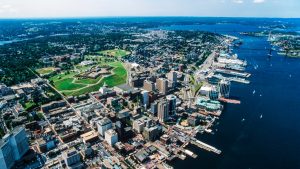Nova Scotia’s headline statistics are, on balance, painting a rather sombre picture of the province’s economic health heading into the second half of 2017.
Turning first to the labour market, over the past twelve months, total employment in the Bluenose province has increased by 0.8% y/y, well below the 1.9% y/y gain posted by the country as a whole.
Against this background of lacklustre job growth, the province’s unemployment rate has remained above 8% for eight of the past twelve months and in June it stood at 8.8%, third highest in the country.
Regarding Nova Scotia’s exports, against a background of strengthening growth in virtually all of the province’s major foreign markets and particularly in the United States (by far its largest foreign customer) the total value of Nova Scotia’s exports year to date is up by only 0.8% compared to the same period in 2016. This very slight rise in exports largely stems from gains in motor vehicle tires (+11.2%) and frozen crabs (+23%) which more than offset a dramatic (-80.5%) drop in natural gas exports.
Among the province’s major trading partners, stronger year-to -date exports to China (+7.3% ), Hong Kong (+50.1%) and South Korea (+33.1%), mainly of lobsters, more than offset a -4.5% retreat in exports to the U.S.
Turning to the key components of domestic demand, given that virtually all of the jobs added over the past twelve months have been part-time and average weekly earnings, year to date, are up by less than 1%, it is not surprising that retail sales year to date are up by only +4.3%. This growth is considerably weaker than the 7% gain posted during the comparable period in 2016.
Consistent with the weak growth of employment and lacklustre weekly earnings, sales of existing homes in Nova Scotia during the first five months of 2017 were essentially unchanged compared to the first five months of 2016.
However, despite this evidence of weak demand, housing starts in the province are up 31% year to date due to the combination of a 13.7% increase in single starts and a 40.7% rise in multiples. Going forward, the effects of a retreat in approvals of multiple units and little change in single-family units suggest that new residential construction will probably moderate in the near term. Over the longer term, new residential construction should continue to be supported by a combination of positive net international migration and a steady increase in rental demand driven by an aging population.
While the outlook for consumer spending and residential construction is rather overcast, recent strength in approvals of commercial, institutional and industrial projects contributed to a solid (43.3%) year-to-date increase in the total value of non-residential construction intentions.
Recently announced commercial projects include the Queen’s Marque in Halifax, the Dartmouth Crossing Retail/Commercial Development and the Bedford Common Development. In the near term industrial construction should benefit from the ongoing construction of six patrol ships at the Irving Shipyards in Halifax.
Also, once the final tender requirements have been finalized, industrial construction should get a further boost from the construction of fifteen combat vessels. Looking further ahead, although there is considerable uncertainty regarding the feasibility of a Nova Scotia LNG facility, the recent decision by Petronas to cancel plans for its Pacific North West LNG project in British Columbia has heighted interest in the "shovel ready" Bear Head LNG project. Given that all approvals are in place, it could, if conditions become favourable, start in 2018 or 2019.
Given the prospect of relatively modest growth in exports, consumer spending and residential construction and the slightly brighter outlook for business investment, we expect that Nova Scotia will grow in the range of 0.5% to 1.5% in 2017 and 2018 following an estimated gain of 0.9% in 2016.







Recent Comments
comments for this post are closed